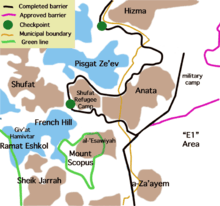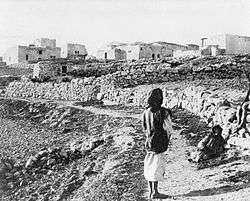'Anata
| 'Anata | |
|---|---|
| Other transcription(s) | |
| • Arabic | عناتا |
| • Also spelled | Anata (official) |
|
'Anata, around 1859[2] | |
 'Anata Location of 'Anata within the Palestinian territories | |
| Coordinates: 31°48′46″N 35°15′43″E / 31.81278°N 35.26194°ECoordinates: 31°48′46″N 35°15′43″E / 31.81278°N 35.26194°E | |
| Palestine grid | 174/135 |
| Governorate | Jerusalem |
| Government | |
| • Type | Village council |
| • Head of Municipality | Ahmad Kamil Alrifai |
| Area | |
| • Jurisdiction | 30,603 dunams (30.6 km2 or 11.8 sq mi) |
| Population (2006) | |
| • Jurisdiction | 9,600 |
| Name meaning | Anata, personal name[3] |

'Anata (Arabic: عناتا) is a Palestinian town in the Jerusalem Governorate in the central West Bank, located four kilometers northeast of Jerusalem's Old City. According to the Palestinian Central Bureau of Statistics, 'Anata had a population of 9,600 in 2006.[4] Its total land area is 30,603 dunams, of which over half now lies within the Israeli Jerusalem municipality and 1,654 is Palestinian built-up area.[5] Since 1967, 'Anata has been occupied by Israel. Together with Shu'afat refugee camp, the village is almost surrounded by the separation barrier, cutting it off from Jerusalem and surrounding villages except for a checkpoint in the west and a road in the north-east that gives access to the rest of the West Bank.[6]
History
'Anata is a village on an ancient site, old stones have been reused in village homes, and cisterns dug into rock have been found, together with caves and ancient agricultural terraces.[7] Edward Robinson identified 'Anata with Biblical Anathoth, birthplace of Jeremiah, in his Biblical researches in Palestine.[8]
There are ruins of a Byzantine-era church in the town, proving that it was inhabited prior to the Muslim conquest of Palestine by the Rashidun Caliphate in the 7th century.[9][10] Ahead of the 1187 Muslim siege of Jerusalem against the Crusaders, Saladin, the Ayyubid general and sultan, situated his administration in 'Anata before he proceeded towards Jerusalem.[5]
Ottoman era
The village was incorporated into the Ottoman Empire in 1517 with all of Palestine, and in 1596 'Anata appeared in Ottoman tax registers as being in the Nahiya of Quds of the Liwa of Quds. It had a population of 10 Muslim households, and paid taxes on wheat, barley, summer crops, olive trees, fruit trees, goats and/or bee hives.[11]
The village was destroyed by Ibrahim Pasha in 1834 following a pro-Ottoman Arab revolt against Egyptian rule.[5] When W. M. Thomson visited it in the 1850s, he described it as a "small, half-ruined hamlet, but it was once much larger, and appears to have had a wall around it, a few fragments of which are still to be seen."[12] According to information received by Clermont-Ganneau in 1874, the village was settled by Arab families from Khirbet 'Almit, a mile to the northeast.[9][13]
The French explorer Victor Guérin visited the village in 1863, and described it as being a small, situated on a hill, and with 200 inhabitants.[14] An official Ottoman village list of about 1870 showed that 'Anata had 25 houses and a population of 70, though the population count included only men.[15]
In 1883, the Palestine Exploration Fund's Survey of Western Palestine described it as a "village of moderate size, the houses of stone; it stands on a ridge commanding a fine view to the north and east. ...There are a few olives round the village, and a well on the west and another on the south-east."[16]
British Mandate era
In the 1922 census of Palestine conducted by the British Mandate authorities, 'Anata had a population of 285, all Muslim.[17] This had increased in the 1931 census of Palestine to 438, still all Muslim, in 98 houses.[18]
In 1945 'Anata had a population of 540, all Arabs, with 18,496 dunams of land, according to an official land and population survey.[19] Of this, 353 dunams were plantations and irrigable land, 2,645 used for cereals,[20] while 35 dunams were built-up land.[21]
1948-1967
In the wake of the 1948 Arab–Israeli War, 'Anata came under Jordanian rule. In 1961, the population was 852.[22]
Post-1967
After the Six-Day War in 1967, 'Anata has been under Israeli occupation. The families are Abd al-Latif, Ibrahim, Alayan, Hilwa, Salama, Hamdan, Abu Haniya Musah and al-Kiswani. The latter family fled to 'Anata during the 1948 Arab-Israeli War.[5]
According to the Palestinian NGO Applied Research Institute–Jerusalem, the Israeli settlements of Alon, Nofei Prat, Kfar Adumim and Almon are all located on 'Anata land.[5]
Sanctuaries

'Anata contains two sanctuaries, dedicated to Saleh and possibly Jeremiah. The former is a mosque dedicated to the prophet Saleh (Biblical Shelah), but Saleh's tomb is believed to be in the village of Nabi Salih to the northwest. The latter sanctuary is a cave dedicated to a "Rumia" which according to Charles Simon Clermont-Ganneau, "looks as if it had been connected by the folklore with the name Jeremiah, the initial 'je' being removed by aphaeresis as so frequently happens in Arabic." This signifies that it is very possible that "Rumia" is an Arabicized form of "Jeremiah".[9][13]
Government
Before 1996, 'Anata was governed by a mukhtar. Since then a village council was established to govern the town. According to the village council of 'Anata, about 97% of its land outside Jerusalem is under complete Israeli control. The boundaries of the village span about 30,603 dunams, although only 1,654 dunams are designated as a built-up area, most of which is under the civil administration of the Palestinian National Authority and the security of Israel.[5] The village boundaries are far-reaching and stretch from 'Anata itself to just east of the Israeli settlement Alon. Most of the land is undeveloped open space with little or no vegetation.[23]
References
- ↑ Thomson, 1859, vol 2, p. 549
- ↑ Thomson, 1859, vol 2, p. 549
- ↑ Palmer, 1881, p. 283
- ↑ Projected Mid -Year Population for Jerusalem Governorate by Locality 2004- 2006 Palestinian Central Bureau of Statistics.
- 1 2 3 4 5 6 'Anata Town Profile Applied Research Institute - Jerusalem. 21 July 2004.
- ↑ Btselem (Nov 2014) Map of the West Bank, Settlements and the Separation Barrier
- ↑ Dauphin, 1998, p. 899
- ↑ Robinson and Smith, 1841, vol 2, p. 109
- 1 2 3 Sharon, 1999, p. 87
- ↑ Conder and Kitchener, 1883, SWP III, p. 82
- ↑ Hütteroth and Abdulfattah, 1977, p. 117
- ↑ Thomson, 1859, vol 2, p. 548
- 1 2 Clermont-Ganneau, 1896, vol 2, pp. 276-7
- ↑ Guérin, 1869, p. 76 ff
- ↑ Socin, 1879, p. 143
- ↑ Conder and Kitchener, 1883, SWP III, pp. 7-8
- ↑ Barron, 1923, Table VII, Sub-district of Jerusalem, p. 14
- ↑ Mills,1932, p. 37
- ↑ Government of Palestine, Department of Statistics. Village Statistics, April, 1945. Quoted in Hadawi, 1970, p. 56
- ↑ Government of Palestine, Department of Statistics. Village Statistics, April, 1945. Quoted in Hadawi, 1970, p. 101
- ↑ Government of Palestine, Department of Statistics. Village Statistics, April, 1945. Quoted in Hadawi, 1970, p. 151
- ↑ Government of Jordan, p. 23
- ↑ Land Use/Land Cover Map of 'Anata Village Boundary (Map). Applied Research Institute of Jerusalem.
Bibliography
| Wikimedia Commons has media related to 'Anata. |
- Barron, J. B., ed. (1923). Palestine: Report and General Abstracts of the Census of 1922. Government of Palestine.
- Clermont-Ganneau, Charles Simon (1896). [ARP] Archaeological Researches in Palestine 1873-1874, translated from the French by J. McFarlane. 2. London: Palestine Exploration Fund.
- Conder, Claude Reignier; Kitchener, H. H. (1883). The Survey of Western Palestine: Memoirs of the Topography, Orography, Hydrography, and Archaeology. 3. London: Committee of the Palestine Exploration Fund.
- Dauphin, Claudine (1998). La Palestine byzantine, Peuplement et Populations. BAR International Series 726 (in French). III : Catalogue. Oxford: Archeopress. ISBN 0-860549-05-4.
- Guérin, Victor (1869). Description Géographique Historique et Archéologique de la Palestine (in French). 1: Judee, pt. 3. Paris: L'Imprimerie Nationale.
- Government of Jordan, Department of Statistics (1964). First Census of Population and Housing. Volume I: Final Tables; General Characteristics of the Population (PDF).
- Hadawi, Sami (1970). Village Statistics of 1945: A Classification of Land and Area ownership in Palestine. Palestine Liberation Organization Research Center.
- Hütteroth, Wolf-Dieter; Abdulfattah, Kamal (1977). Historical Geography of Palestine, Transjordan and Southern Syria in the Late 16th Century. Erlanger Geographische Arbeiten, Sonderband 5. Erlangen, Germany: Vorstand der Fränkischen Geographischen Gesellschaft. ISBN 3-920405-41-2.
- Mills, E., ed. (1932). Census of Palestine 1931. Population of Villages, Towns and Administrative Areas. Jerusalem: Government of Palestine.
- Palmer, E. H. (1881). The Survey of Western Palestine: Arabic and English Name Lists Collected During the Survey by Lieutenants Conder and Kitchener, R. E. Transliterated and Explained by E.H. Palmer. Committee of the Palestine Exploration Fund.
- Robinson, Edward; Smith, Eli (1841). Biblical Researches in Palestine, Mount Sinai and Arabia Petraea: A Journal of Travels in the year 1838. 2. Boston: Crocker & Brewster.
- Sharon, Moshe (1997). Corpus Inscriptionum Arabicarum Palaestinae, Vol. I, A. BRILL. ISBN 9004108335.
- Socin, A. (1879). "Alphabetisches Verzeichniss von Ortschaften des Paschalik Jerusalem". Zeitschrift des Deutschen Palästina-Vereins. 2: 135–163.
- Thomson, William McClure (1859). The Land and the Book: Or, Biblical Illustrations Drawn from the Manners and Customs, the Scenes and Scenery, of the Holy Land. 2 (1 ed.). New York: Harper & brothers.
External links
- Welcome To 'Anata
- Survey of Western Palestine, Map 17: IAA, Wikimedia commons
- 'Anata Town (Fact Sheet), ARIJ; The Applied Research Institute – Jerusalem
- 'Anata Town Profile, ARIJ; The Applied Research Institute – Jerusalem
- 'Anata aerial photo, ARIJ; The Applied Research Institute – Jerusalem
%2C_p._549_in_Thomson%2C_1859.jpg)
